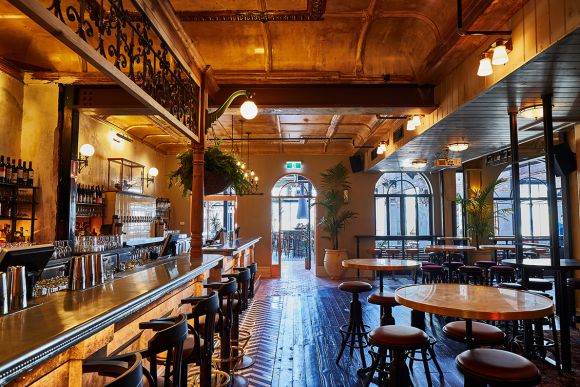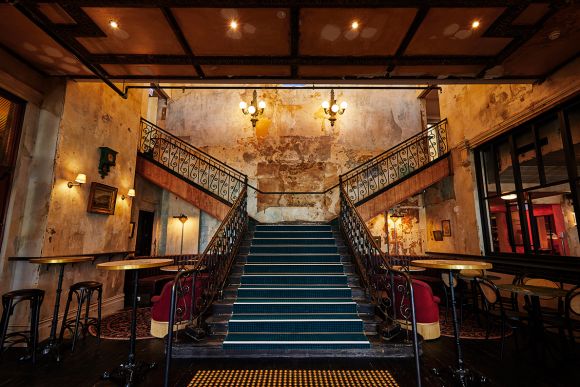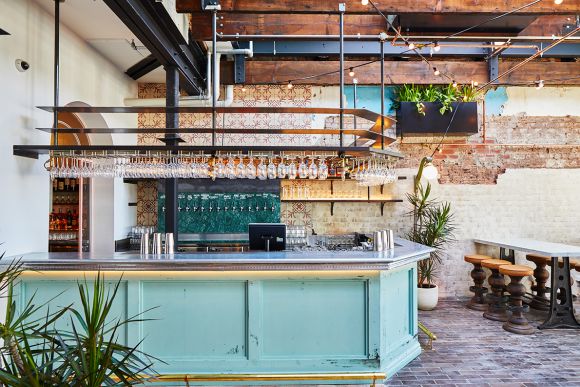
First built in 1878, The Espy has experienced a number of alterations and additions over the years – namely in the 1920’s and 1970’s – before being acquired by Carlton and United Breweries in 1995 and then by Becton Corporation in 1997. Becton sought to develop a 35-storey residential tower on the site, which was eventually scaled back to a more modest seven-storeys following strong community opposition.

The Espy, represents Technē’s largest and most complex hospitality undertaking to date, and is 50 per cent larger than Garden State Hotel, which Technē also worked on with Sand Hill Road. Technē’s design strategy reflects Sand Hill Road’s vision for the venue; highlighting the different eras across 12 bars, two restaurants and a variety of discrete spaces totalling 3,000 sqm which can accommodate up to 1,780 patrons.
Since day one, The Espy has been a Victorian-era seaside resort and the hotel home to notable personalities such as entrepreneur, art collector and philanthropist Alfred Felton. It’s been a jazz-era ballroom and a rock and roll mainstay from the 1990s until 2015 when it closed for renovation.
Technē’s design features three different spaces capable of accommodating a range of performances from intimate jazz or stand-up comedy to rock bands drawing big crowds in the Gershwin Room – a space which Technē has left largely untouched.
The Espy further celebrates its musical heritage with vintage rock posters on display throughout the building, sourced from the venue’s archives. The renovations have also opened up and activated the Espy’s second level, expanding the public offering from two levels to four. An operable glass roof has been provided over the famous terrace entrance and highlights the grand stairway that connects the building’s different levels.
On the ground floor, the foyer’s grand arch windows provide a visual connection through to the Main Bar and to a cellar door-inspired dining area, complete with wine barrels filling the walls, and kitchen beyond. The former Espy kitchen has been re-imagined as a public bar featuring traditional curved oak detailing.

Cantonese restaurant Mya Tiger is located on the first floor and draws inspiration from the famous Raffles Hotel in Singapore, providing patrons with views of Port Phillip Bay in addition to the activity on the terrace below. Felton’s spirit of art collecting and as a host of salons for the creative community informs the Technē design response on the second floor.
Other areas include a small mezzanine-level function room and the 1950s inspired Studio Bar on the ground floor, a space that patrons can book to record podcasts, providing what Technē term “a slightly more modern character” compared to some of the venue’s other restored spaces, with diner-style booths and ’50s-style wood panelling.

A series of hand-painted, period-style murals by Perth artist Desmond Sweeney (8 Foot Walls) provide a unique design feature, with one occupying an entire eight metre wall in the the Green Room.
Technē worked closely with Sand Hill Road stylist Eleisha Gray on conceiving the interior design and decor of the reborn Espy, curating a selection of imported furniture and decorative objects in keeping with the overall narrative. A tribute to The Espy’s heyday, Technē and Sandhill Road’s transformation will ensure the St Kilda landmark remains one of the oldest, largest and most prominent 19th-century hotel resorts still operating in Victoria.
In addition to The Espy redevelopment, a host of other projects such as the recently completed Gatwick Hotel redevelopment as part of The Block TV series, and the Victorian Pride Centre are breathing new life into St Kilda. A snapshot of the the area’s development pipeline is captured below.
Resource from https://www.urban.com.au/design/2018/11/21/the-espy-a-st-kilda-landmark-is-reborn